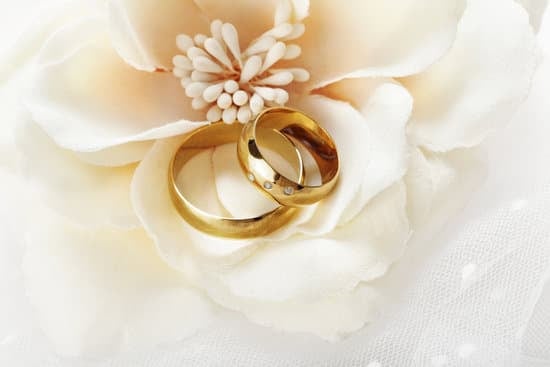A wedding ring is a universal symbol of love and commitment, but have you ever wondered where does the wedding ring go? This simple piece of jewelry holds immense significance in different cultures around the world. From ancient traditions to modern trends, the wedding ring carries a rich history and cultural importance that transcends borders.
In many cultures, the wedding ring is worn on the fourth finger of the left hand, known as the “ring finger.” This custom can be traced back to ancient Egypt, where it was believed that this finger contained a vein that led directly to the heart. This symbolic gesture represents a deep connection between two individuals who are united in marriage.
The tradition of exchanging rings during wedding ceremonies dates back centuries, with each culture infusing its unique customs and meanings into this ritual. Whether it’s a simple band or a lavish design, wedding rings are not just accessories but a reflection of one’s commitment, values, and cultural identity. Understanding the significance of the wedding ring in different cultures sheds light on the diverse ways people express their love and devotion through this timeless symbol.
History of the Wedding Ring Tradition
The tradition of exchanging wedding rings dates back thousands of years and holds deep cultural and symbolic significance in various societies around the world. It is a universal symbol of love, commitment, and unity between partners. The circular shape of the ring represents eternity, with no beginning or end, reflecting the eternal bond shared by the couple. This gesture not only signifies a marriage commitment but also serves as a visible symbol to others, indicating the wearer’s marital status.
Historical Origins
The practice of wearing wedding rings can be traced back to ancient Egypt, where rings made from materials like leather or reeds were exchanged during ceremonies to symbolize eternal love. The circle was believed to represent an unbreakable bond between husband and wife.
Over time, this custom spread to other civilizations such as ancient Rome, where iron rings were given to signify a legal agreement between spouses. The tradition evolved further in medieval Europe when rings made from precious metals like gold became popular among nobility as a sign of wealth and status.
Evolution of Tradition
As time passed, the symbolism behind wedding rings continued to evolve across different cultures. In some traditions, such as in Hindu weddings, both partners may wear toe rings instead of finger rings as a symbol of their union.
In Jewish ceremonies, couples exchange plain bands without any embellishments as a reminder of simplicity and humility in marriage. Regardless of variations in customs and designs, the underlying meaning remains consistent – the wedding ring is a tangible expression of love and commitment that transcends time and place.
Different Types of Wedding Rings and Their Meanings
When it comes to choosing a wedding ring, there are numerous options available, each with its own unique meaning and significance. From traditional bands to more modern styles, the type of wedding ring you choose can say a lot about your relationship and personal style.
Traditional Bands
Traditional wedding bands are simple metal rings without any additional embellishments. These classic designs symbolize the eternal bond between two people and are often chosen for their timeless appeal. They are typically made from gold, silver, or platinum, with some couples opting for matching bands to signify their unity.
Gemstone Rings
Gemstone wedding rings have become increasingly popular in recent years, adding a pop of color and personality to the traditional band. From sapphires to emeralds, couples can choose a gemstone that holds special meaning for them or simply reflects their individual style. These rings can also incorporate diamonds for a touch of sparkle and luxury.
Customized Rings
For those looking for something truly unique, customized wedding rings offer a personalized touch. Couples can work with designers to create one-of-a-kind rings that reflect their love story, whether through engraving meaningful dates or symbols on the band or incorporating specific design elements that hold significance to them. Customized rings allow couples to create a piece of jewelry that is truly their own and speaks to their relationship in a special way.
Placement of the Wedding Ring in Various Countries and Cultures
The placement of the wedding ring is a gesture that holds deep meaning in various countries and cultures around the world. While the tradition of exchanging wedding rings is prevalent in most cultures, the way in which they are worn can differ significantly. From wearing it on the left hand to placing it on the right hand, each culture has its unique significance attached to the placement of the wedding ring.
In Western cultures, such as in the United States and Europe, it is customary to wear the wedding ring on the ring finger of the left hand. This tradition dates back to ancient Roman times when it was believed that the vein in this finger, known as “vena amoris” or the vein of love, directly connected to the heart. This romantic symbolism has been carried through generations and is now a widely accepted practice in Western weddings.
On the other hand, in some Eastern cultures like India and Russia, it is common for couples to wear their wedding rings on their right hand. In India, for example, rings are traditionally worn on the right hand as it is believed to be closer to one’s heart chakra according to Ayurvedic traditions.
Similarly, Russian couples often exchange and wear their wedding rings on their right hands as well. These cultural differences showcase how something as simple as where a wedding ring goes can hold diverse meanings across different parts of the world.
To provide a clearer picture of how wedding rings are placed in various countries and cultures, here is a breakdown:
- United States: Left Hand
- Europe: Left Hand
- India: Right Hand
- Russia: Right Hand
Understanding these cultural nuances adds an extra layer of depth and sentimentality to wearing a wedding ring. Whether you choose to follow traditional customs or create your own unique placement ritual with your partner, where you decide to wear your wedding ring can serve as a beautiful symbol of your love and commitment.
Wedding Ring Trends in Modern Times
In modern times, the tradition of wearing wedding rings has evolved to include various trends that reflect individual styles and preferences. One prominent trend is the rise of personalized and unique wedding rings. Couples are increasingly opting for custom-designed rings that showcase their personalities and love story. From engraving special dates or initials to choosing non-traditional gemstones, the possibilities are endless when it comes to creating a one-of-a-kind wedding ring.
Another popular trend in modern times is the preference for alternative metals in wedding ring designs. While traditional metals like gold and platinum remain classic choices, many couples are exploring options such as titanium, tungsten, or even wood for a more contemporary look. These unconventional materials not only offer durability but also add a distinctive touch to the wedding ring.
Furthermore, sustainability is becoming a significant trend in the world of wedding rings. With an increased focus on ethical sourcing and environmental consciousness, more couples are choosing eco-friendly options for their rings. This includes selecting recycled metals or lab-grown diamonds to minimize the impact on the environment. By embracing sustainable practices, couples can symbolize their commitment not only to each other but also to the planet.
| Wedding Ring Trend | Description |
|---|---|
| Personalized Designs | Couples opt for custom-designed rings that reflect their personalities and love story. |
| Alternative Metals | Rise in popularity of metals like titanium and tungsten for a modern look. |
| Sustainability | Increasing preference for eco-friendly options such as recycled metals and lab-grown diamonds. |
How to Choose the Perfect Wedding Ring for Your Partner
The wedding ring is a powerful symbol of love and commitment, with its circular shape representing eternity and the unending nature of the marriage bond. When it comes to choosing the perfect wedding ring for your partner, there are several factors to consider. One important aspect to think about is the metal of the ring.
Common choices include gold, white gold, rose gold, platinum, and titanium. Each metal has its own unique properties in terms of durability, color, and price point.
Another crucial consideration when selecting a wedding ring is the style that best suits your partner’s taste and lifestyle. Some popular options include classic bands, diamond-encrusted rings, vintage-inspired designs, or custom-made creations. It’s essential to take into account your partner’s personal style preferences and everyday activities when making this decision. Additionally, you may want to think about whether you want matching wedding rings or ones that complement each other while reflecting your individual personalities.
Furthermore, budget plays a significant role in choosing the perfect wedding ring. Wedding rings come in a wide range of prices depending on factors such as metal type, design complexity, and any gemstones included.
Setting a realistic budget before starting your search can help narrow down your options and ensure you find a ring that both meets your partner’s desires and fits within your financial means. Remember that it’s not about the price tag but rather the sentiment behind the ring that truly matters in this special token of love.
| Aspect | Consideration |
|---|---|
| Metal | Gold, white gold, rose gold platinum or titanium |
| Style | Classic bands, diamond-encrusted rings bespoke designs |
| Budget | Set realistic budget prior searching. |
Wedding Ring Traditions Around the World
Wedding ring traditions vary significantly across different cultures and countries, each holding its unique symbolism and customs. In some cultures, the wedding ring is worn on the left hand, while in others, it’s placed on the right hand.
For instance, in Western cultures like the United States and most European countries, the wedding ring is typically worn on the fourth finger of the left hand. This tradition stems from ancient beliefs that this finger contains the “vena amoris” or the “vein of love” that connects directly to the heart.
On the other hand, in countries like Russia and India, it’s common for couples to wear their wedding rings on their right hand. In Russia, this tradition dates back to Tsarist times when wearing a ring on the right hand signified strength and power. Similarly, in India, wearing a wedding ring on the right hand is influenced by cultural norms and religious beliefs specific to each region.
Here are some examples of where does the wedding ring go around the world:
- United States: Left-hand fourth finger
- United Kingdom: Left-hand third finger
- India: Right-hand third finger
- Russia: Right-hand fourth finger
Understanding these cultural differences adds depth and meaning to such a significant symbol of love and commitment shared between partners worldwide.
Tips on Caring for Your Wedding Ring to Ensure Longevity and Shine
In conclusion, the wedding ring holds immense significance in various cultures around the world, symbolizing love, commitment, and unity between partners. From ancient traditions to modern trends, the wedding ring has evolved in design and meaning but continues to be a cherished symbol of marriage.
When it comes to the placement of the wedding ring, different countries and cultures have their own customs. Whether it’s worn on the left hand or right hand, on which finger, or with specific engravings or designs, the wedding ring placement can vary widely. However, no matter where does the wedding ring go, its symbolism remains constant – a tangible representation of a couple’s eternal bond.
As you embark on your journey to choose the perfect wedding ring for your partner, consider not only the style and design that speak to their tastes but also take into account important factors such as durability and long-term care. By following tips on caring for your wedding ring – such as regular cleaning, avoiding harsh chemicals, and storing it properly when not in use – you can ensure its longevity and shine for years to come.
Remember that your wedding ring is not just a piece of jewelry; it is a testament to your enduring love and commitment.
Frequently Asked Questions
Which Finger Does a Wedding Ring Go On?
The traditional finger for a wedding ring to go on is the fourth finger of the left hand, also known as the ring finger. This practice dates back to ancient times when it was believed that this finger contained a vein connected directly to the heart.
Where Do You Put Wedding Ring?
Most people wear their wedding rings on the ring finger of their left hand. This tradition is widely accepted in many cultures around the world. However, some individuals may choose to wear their wedding ring on a different hand or finger based on personal preference or cultural norms.
Can I Wear My Wedding Ring on My Right Hand?
Yes, you can wear your wedding ring on your right hand if you prefer. While it is common in many Western cultures to wear the wedding ring on the left hand, there are no strict rules dictating which hand you must wear it on.
Ultimately, it is up to personal preference and what feels most comfortable for you as an individual.

I have been involved in marriages for over 20 years helping couples and singles understand more about them.





